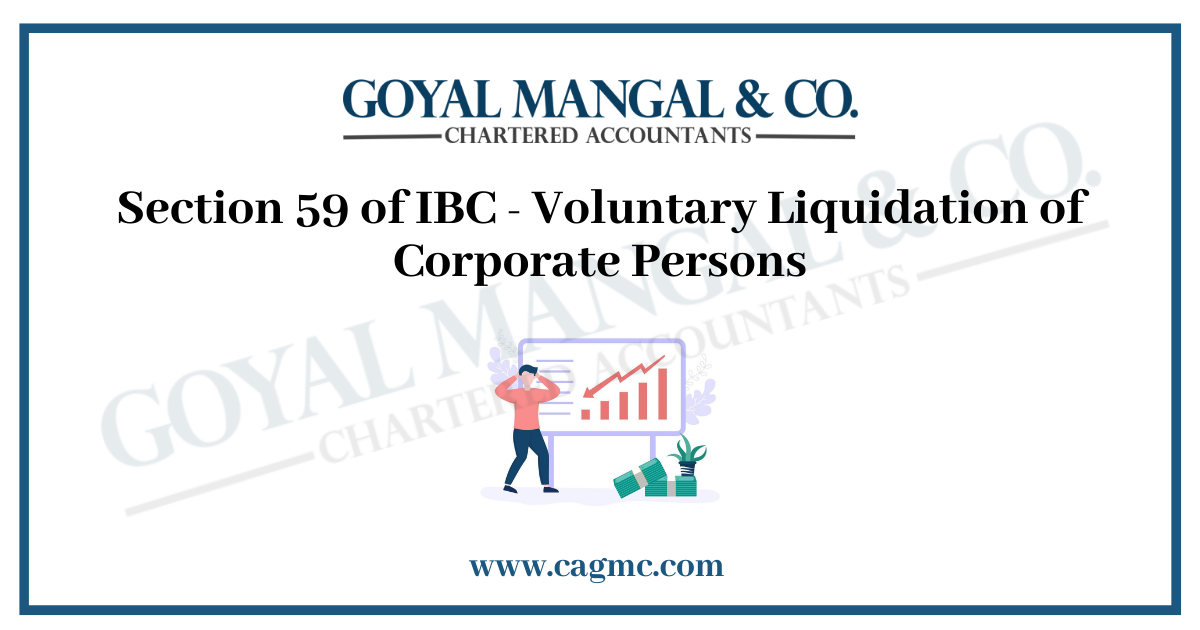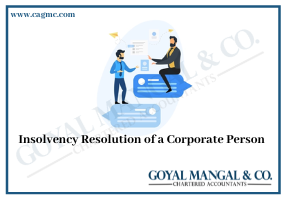
If you are running your own business and want to dissolve it then, voluntary liquidation may be the best option. In business, sometimes things don’t work out as we plan. Sometimes, we need to cut our losses and start fresh. In India, bad debts keep on increasing. Further, among total bad debt corporate bad debt constitute about 56%. The Insolvency and Bankruptcy Code, 2016 (IBC) was brought in place to make the process simpler and make it easier. In this article we will discuss Section 59 of IBC – Voluntary Liquidation of Corporate Persons.
|
Table of Content |
Meaning of Insolvency and Bankruptcy
Insolvency means the short-term inability to meet the liabilities during the normal course of business. However, it can be resolved by changing the re-payment plan of the loan. However, if it cannot be resolved then legal action may be taken.
Bankruptcy is slightly different from insolvency. Bankruptcy means long-term inability to meet the liabilities. Further, the person himself voluntarily declares themselves insolvent and approaches the court.
Chapter V of IBC
Section 59 of Chapter V of Insolvency and Bankruptcy Code, 2016, talks about the Voluntary Liquidation of Corporate Persons. This chapter states the procedure for Voluntary Liquidation of Corporate Persons initiation and effect of Liquidation, power, and duties of Liquidator, and completion of Liquidation.
Further, Section 59(1) states that if a corporate person intends to liquidate the company voluntarily and proves that it has not committed any default. Itcan initiate proceedings of the Voluntary Liquidation process as described under the provisions of chapter V of the IBC.
Moreover, The sub-section (1) of 59, states that Voluntary Liquidation of Corporate Persons shall meet all the conditions or procedural requirements as prescribed by the Insolvency and Bankruptcy Board.
Applicability and Essential Pre-Condition of Voluntary Liquidation
A corporate person incorporated with limited liability under any law, who intends to liquidate itself voluntarily, can initiate liquidation process under the provisions of Section 59 of Chapter V of Insolvency and Bankruptcy Code.
Further, there are certain essential pre-condition that need to be met. The IBC provides that only those corporate persons can make an application that,
- has not committed any default
- has not defaulted in payment
- has a full capacity to repay debt
are eligible for making an application for voluntary liquidation.
Document Requirement
There are certain documents that you need to attach for the deceleration of Solvency,
- An audited financial statements for the previous two years or for the period when the Company is incorporated or established as the Company
- The record of business operations of the Company for the previous two years or the period since its incorporation
- Youneed to give the valuation of the assets of the Company if there is any which the registered Valuer prepares
Further, you also have to provide a list of each debt that the Company (Corporate Person) owes. Moreover, the deceleration of solvency has to to filled in FORM GNL-2.
Process of Voluntary Liquidation
The following is the procedure for the Voluntary Liquidation of a Corporate Person,
- Declaration of Solvency
As per Section 59(3)(a)(i) of the IBC the directors of the Company has to make a Declaration of Solvency in the form of an Affidavit. In the said affidavit they have to conform that,
a) The company has not committed any default
b) It is solvent
c) The company is not being liquidated to defraud any person
- Board Meeting
The company has to call a board meeting. The board will have to decide on the following,
a) Voluntary Liquidation of the Company
b) Appointment of Insolvency Professional
c) Fixing the day, date and time of the general meeting
- General Meeting
The General Meeting of the Share Holders has to be within 4 weeks of the Declaration of Solvency. Further, they have to pass the following,
a) Appointing Liquidator of the Company
b) Liquidating the Company voluntarily
- Creditors Resolution (Conditional)
If a company has creditors, then a resolution has to be passed by creditors holding 2/3rd of the debt within 7 days of the members resolution.
- Communication to ROC and IBBI
After obtaining approval from the members and creditors for under going liquidation the company has to forward the same to ROC and IBBI within 7 days of obtaining the same.
- Appointment of Liquidator
The company has to appoint an Insolvency Professional as a Liquidator to conduct the Voluntary Liquidation process. Further, they have to be registered with the Insolvency and Bankruptcy Board of India (IBBI).
- Public Announcement
The liquidator has to make a public announcement within 5days of his appointment. The announcement should should call the stakeholders to submit their claims within 30 days from the liquidation commencement date.
Further, the liquidator has to prepare a list of stake holders within 45 days from last date for the receipt of claims.
- Submission of Claims
Anyone who submits their claims, has to do so within the given time period. Further, they have to provide proof of their claims of the debts owed to them.
- Verification of Claims
On receiving the claims, the Liquidator has to verify them within 30 days of receiving them. Further, the Liquidator also has the determine the amount of the claim that the claimant shall receive.
- Realisation of Assets
The liquidator has to realise and recover the assets of the company in order to maximize the value of the company. The same amount must be deposited in a bank account opened for the same purpose.
- Distribution
The money realised has to be distributed to the stake holders within 6 months. If any asset cannot be realised due to its nature or circumstance, the liquidator may distribute it as such with the approval of the company. - Completion of Liquidation
The Liquidator has to complete the process within 12 months of its commencement. Further, they may hold a meeting of the contributory within 15 days at the end of every succeeding 12 months till the dissolution is complete. - Final Report
Once the Liquidation process is completed, the liquidator has to prepare the Final Report containing,
a) Audited accounts of the liquidation
b) A statement showing the assets are disposed of, debts are discharged and no litigation is pending
c) A sale statement of assets showing realized value, its cost, manner, and mode of sale, any shortfall, to whom it is sold, etc
- Filing Report to ROC and NCLT
The same report is sent to the concerned Registrar of Companies (ROC), NCLT and the IBBI.
- Filing of Order
The NCLT shall then pass an order that the company stands dissolved. Further, a copy of the order is passed to the registrar where the company is registered.
Effect of Voluntary Liquidation to the status of a Corporate Person
The corporate person from the date of Voluntary Liquidation Commencement shall cease to carry on its business except in the case of benefiting winding up its business. This is governed by the Regulation 6 of Insolvency and Bankruptcy Board of India (Voluntary Liquidation Process) Regulation, 2017.
Conclusion
Many businesses do not survive the changing markets. If your business is one of them, they you can cut your losses by voluntarily liquidating your company. The Indian government has made it easy for corporate person’s to declare Insolvency. Moreover, this is to decrease the corporate bad debt in the country.


